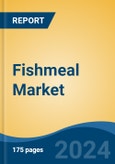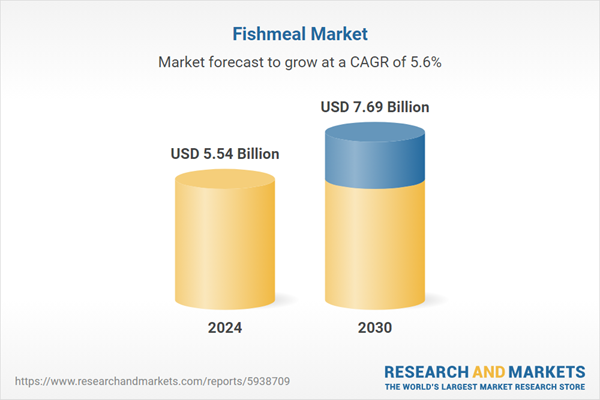Free Webex Call
The Fishmeal Market was valued at USD 5.54 Billion in 2024, and is expected to reach USD 7.69 Billion by 2030, rising at a CAGR of 5.62%. The global fishmeal market has experienced steady growth, driven by the increasing demand for high-protein animal feed, particularly in aquaculture and livestock industries. The market size is influenced by factors such as population growth, rising per capita income, and a growing preference for seafood. Speak directly to the analyst to clarify any post sales queries you may have.
10% Free customizationThis report comes with 10% free customization, enabling you to add data that meets your specific business needs.
The global fishmeal market is characterized by steady growth driven by the expansion of aquaculture and livestock industries, increasing awareness of sustainability, and the nutritional benefits of fishmeal. However, challenges such as sustainability concerns, raw material fluctuations, and competition from alternatives exist. The industry is expected to evolve with technological advancements, traceability initiatives, and the exploration of new market segments. It's crucial to stay updated on the latest industry trends for a comprehensive understanding of the global fishmeal market.
Key Market Drivers
Increasing Demand for Aquaculture Products
The increasing demand for aquaculture products stands as a pivotal driver propelling the growth of the global fishmeal market. This phenomenon is rooted in several interconnected factors that collectively contribute to the expansion of the market. The surge in the global population has led to a heightened demand for protein-rich food sources. With traditional capture fisheries facing sustainability challenges and limited capacity to meet the growing protein needs, aquaculture has emerged as a viable and sustainable solution. As a primary ingredient in aquafeed, fishmeal plays a crucial role in providing the essential nutrients required for the optimal growth of farmed fish. This demand for high-quality protein sources aligns with the goals of aquaculture, thereby driving the consumption of fishmeal.Key Market Challenges
Sustainability Concerns and Overfishing
The primary challenges facing the fishmeal market is the sustainability of its primary raw material - fish. Overfishing in certain regions and the depletion of fish stocks pose significant sustainability concerns. The extraction of large quantities of fish for fishmeal production can contribute to ecosystem imbalances, negatively impacting marine biodiversity. As consumers and regulatory bodies increasingly prioritize sustainable sourcing, the fishmeal industry faces the challenge of balancing its production needs with the imperative to ensure the long-term health of fish populations and marine ecosystems.Key Market Trends
Rising Demand for Aquaculture Products
The prominent trend driving the growth of the global fishmeal market is the increasing demand for aquaculture products. Aquaculture has experienced significant expansion as a sustainable solution to meet the growing global demand for seafood. Fishmeal is a crucial component in aquafeed formulations, providing essential nutrients for the optimal growth and health of farmed fish. As aquaculture continues to grow, especially in emerging markets, the demand for high-quality and nutritionally balanced aquafeed is on the rise, propelling the consumption of fishmeal.Key Market Players
- Triplenine Group A/S
- Pesquera Diamante S.A.
- Ff Skagen A/S
- Biomega AS
- Sarma Fish S.A.R.L
- Aker BioMarine Antarctic AS
- Omega Protein Corporation
- Calysta, Inc.
- Novus International Inc.
- Alpha Atlantique
Report Scope:
In this report, the Global Fishmeal Market has been segmented into the following categories, in addition to the industry trends which have also been detailed below:Fishmeal Market, By Application:
- Fertilizers
- Animal Feed
Fishmeal Market, By End-User:
- Swine
- Poultry
- Aquaculture
- Others
Fishmeal Market, By Region:
- North America
- United States
- Canada
- Mexico
- Europe
- France
- United Kingdom
- Italy
- Germany
- Spain
- Asia-Pacific
- China
- India
- Japan
- Australia
- South Korea
- South America
- Brazil
- Argentina
- Colombia
- Middle East & Africa
- South Africa
- Saudi Arabia
- UAE
Competitive Landscape
Company Profiles: Detailed analysis of the major companies present in the Global Fishmeal Market.Available Customizations:
With the given market data, the publisher offers customizations according to a company's specific needs. The following customization options are available for the report.Company Information
- Detailed analysis and profiling of additional market players (up to five).
This product will be delivered within 1-3 business days.
Table of Contents
1. Product Overview
2. Research Methodology
3. Executive Summary
4. Global Fishmeal Market Outlook
5. North America Fishmeal Market Outlook
6. Europe Fishmeal Market Outlook
7. Asia Pacific Fishmeal Market Outlook
8. South America Fishmeal Market Outlook
9. Middle East and Africa Fishmeal Market Outlook
10. Market Dynamics
11. Market Trends & Developments
13. Porter’s Five Forces Analysis
14. Competitive Landscape
Companies Mentioned
- Triplenine Group A/S
- Pesquera Diamante S.A.
- Ff Skagen A/S
- Biomega AS
- Sarma Fish S.A.R.L
- Aker BioMarine Antarctic AS
- Omega Protein Corporation
- Calysta, Inc.
- Novus International Inc.
- Alpha Atlantique
Table Information
| Report Attribute | Details |
|---|---|
| No. of Pages | 180 |
| Published | February 2025 |
| Forecast Period | 2024 - 2030 |
| Estimated Market Value ( USD | $ 5.54 Billion |
| Forecasted Market Value ( USD | $ 7.69 Billion |
| Compound Annual Growth Rate | 5.6% |
| Regions Covered | Global |
| No. of Companies Mentioned | 10 |









